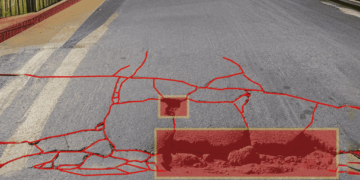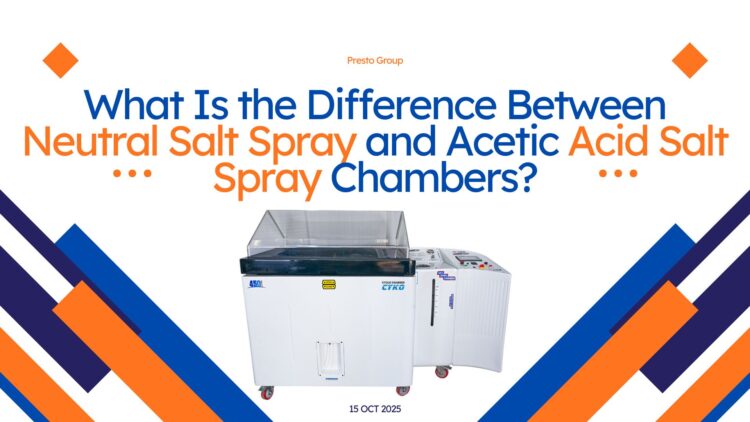Anodising and chromising are two examples of the surface treatments used today, facing the relentless challenge of corrosion on the parts manufactured by the metallic component producers, and coatings rs providers. Accelerated corrosion testing methods are applied to ensure the durability and reliability of these materials — salt spray testing being one of the most popular. This test can be used to approximate how materials and coatings may perform in long-term exposure to mildly humid and saline conditions.
There are two main types of this testing Neutral Salt Spray (NSS) and Acetic Acid Salt Spray (AASS) test chambers. Both involve a fixed salt-laden environment to accelerate corrosion, yet they are very different in term of how they work, where they can/should be applied and how aggressive these tests are.
So let’s see what is the difference between Neutral Salt Spray and Acetic Acid Salt Spray chambers, how they works and in which conditions each method is applicable.
Understanding the Salt Spray Test
The salt spray test (often referred to as the fog test) is a standardized method for evaluating the corrosion resistance of materials and protective coatings. The test exposes specimens to a fine mist of salt solution under controlled temperature and humidity inside a salt spray chamber.
This method is widely recognized in global standards such as ASTM B117, ISO 9227, and JIS Z 2371. The test conditions simulate corrosive environments like marine or coastal atmospheres, where materials are frequently subjected to salt-laden moisture.
By observing the onset and progression of corrosion over a fixed duration, manufacturers can assess the performance of coatings, paints, and plating under accelerated conditions.
What Is a Salt Spray Chamber?
A salt spray chamber (also called a corrosion test chamber) is a closed testing apparatus designed to create a fine fog or mist of salt solution to accelerate the corrosion process.
It comprises several components such as:
- A test chamber where specimens are placed,
- A brine tank containing the salt solution,
- An atomizing tower or nozzle that generates the mist,
- A temperature-controlled heating system, and
- A fog collection and drainage system.
Modern salt spray chambers come with digital controls for temperature, pH monitoring, and test duration. Advanced models, like the CASS cum Salt Spray Chamber, can perform multiple corrosion tests within a single instrument.
Types of Salt Spray Tests
There are three main types of salt spray tests recognized by international standards:-
- Neutral Salt Spray Test (NSS)
- Acetic Acid Salt Spray Test (AASS)
- Copper Accelerated Acetic Acid Salt Spray Test (CASS)
Each test has a different level of aggressiveness and is suited to particular coatings or material types.
1. Neutral Salt Spray (NSS) Test
Principle and Composition
The Neutral Salt Spray test is the most common and widely used corrosion test method. It uses a neutral 5% sodium chloride (NaCl) solution, maintained at a pH of 6.5 to 7.2. The test environment is kept at 35°C ± 2°C.
The term “neutral” refers to the fact that no acidic or basic additives are added — the solution remains chemically neutral.
Test Method
- Specimens are placed inside the chamber at an angle of around 15°–30°.
- A fine mist of saltwater is continuously sprayed into the chamber using compressed air.
- The exposure time varies depending on the coating type — typically ranging from 24 hours to 1000 hours or more.
Applications
The NSS test is commonly used for:-
- Zinc and nickel electroplated coatings
- Painted or powder-coated metal surfaces
- Anodized aluminum
- General corrosion resistance studies
This test serves as a baseline corrosion test for most protective coatings.
2. Acetic Acid Salt Spray (AASS) Test
Principle and Composition
The AASS test (also referred to as the ASS test) is a harsher form of the NSS test. In this instance glacial acetic acid is added to the saline solution to bring down the pH to 3.1-3.3. This acidic condition enhances the rusting process. The temperature of the chamber is kept constant at 35°C ± 2°C as for the NSS test, but the reaction with the acidic solution is more intense and more rapidly evolving.
Test Method
- The same 5% sodium chloride solution is used, but its pH is adjusted with acetic acid.
- The test conditions are maintained consistently throughout the duration.
- The duration of the test is usually shorter than NSS because corrosion appears more rapidly in acidic conditions.
Applications
The AASS test is particularly used for:-
- Decorative coatings such as nickel-chrome plating on steel or brass
- Coatings that require enhanced corrosion resistance verification
- Automotive and hardware components that operate in acidic or polluted environments
3. CASS (Copper Accelerated Acetic Acid Salt Spray) Test
The CASS test is an even more aggressive variant of the AASS test. It uses copper chloride (CuCl₂) along with acetic acid in the salt solution. This combination drastically speeds up the corrosion process, making it suitable for testing high-performance coatings such as:-
- Decorative chrome plating
- Anodized aluminum finishes
- Coatings designed for extreme marine or industrial exposure
A CASS cum Salt Spray Chamber allows manufacturers to perform NSS, AASS, and CASS tests using the same setup with slight adjustments in solution composition and pH.
Key Differences Between Neutral Salt Spray and Acetic Acid Salt Spray Chambers
| Parameter | Neutral Salt Spray (NSS) | Acetic Acid Salt Spray (AASS) |
| Solution Composition | 5% NaCl (neutral pH 6.5–7.2) | 5% NaCl + Acetic Acid (pH 3.1–3.3) |
| Test Environment | Neutral | Acidic |
| Corrosion Rate | Moderate | High (faster corrosion) |
| Temperature | 35°C ± 2°C | 35°C ± 2°C |
| Applications | Zinc, Nickel plating, Paint coatings | Decorative coatings like Nickel-Chrome |
| Duration | Longer exposure (up to 1000 hours) | Shorter exposure (often < 500 hours) |
| Severity | Mild | Aggressive |
| Purpose | General corrosion resistance evaluation | Testing coatings in acidic conditions |
Salt Spray Chamber Standards
The ASTM B117 standard is the most widely recognized guideline for conducting salt spray tests. It defines the apparatus design, solution preparation, temperature control, and specimen evaluation methods.
Other international equivalents include:
- ISO 9227 – Corrosion tests in artificial atmospheres
- JIS Z 2371 – Japanese standard for salt spray testing
- DIN 50021 – German equivalent standard
When purchasing a salt spray chamber, it is important to ensure that it complies with these standards to guarantee reliable and reproducible test results.
Selecting the Right Salt Spray Chamber
When choosing a salt spray chamber, consider the following parameters:-
- Type of test required (NSS, AASS, or CASS)
- Chamber capacity and build quality
- Temperature and humidity controls
- Ease of cleaning and maintenance
- Compliance with ASTM B117 or ISO 9227
PrestoGroup is a Leading salt spray chamber manufacturers in India and abroad offer advanced digital models with automatic pH regulation, fog collection systems, and programmable test cycles.
The salt spray chamber price varies depending on its capacity, features, and test capabilities. A compact model for laboratory use may cost less, while a CASS cum Salt Spray Chamber with multiple test modes will be priced higher due to its versatility.
Conclusion
Both Neutral Salt Spray (NSS) and the Acetic Acid Salt Spray (AASS) chambers are significantly used to evaluate protection against corrosion. The NSS test offers a general evaluation of a coating’s resistance to neutral salt environments, whereas the AASS test adds an acidic factor in testing coatings for more severe environments.
In short:
- Choose NSS for general protective coatings and paints.
- Choose AASS or CASS for decorative or high-performance coatings exposed to acidic or polluted atmospheres.
By using standardized salt spray chambers that comply with ASTM B117, manufacturers can ensure accurate and repeatable results, leading to better product quality and longer material lifespan.
📞 Get Expert Assistance Today!
Looking for the best testing instruments to ensure your products meet top-quality standards?
Talk to our experts and find the perfect solution for your testing needs.
📲 Call Now: +91 9210 903 903
📧 Email: info@prestogroup.com
🌐 Visit Us: www.testing-instruments.com/contact/


















